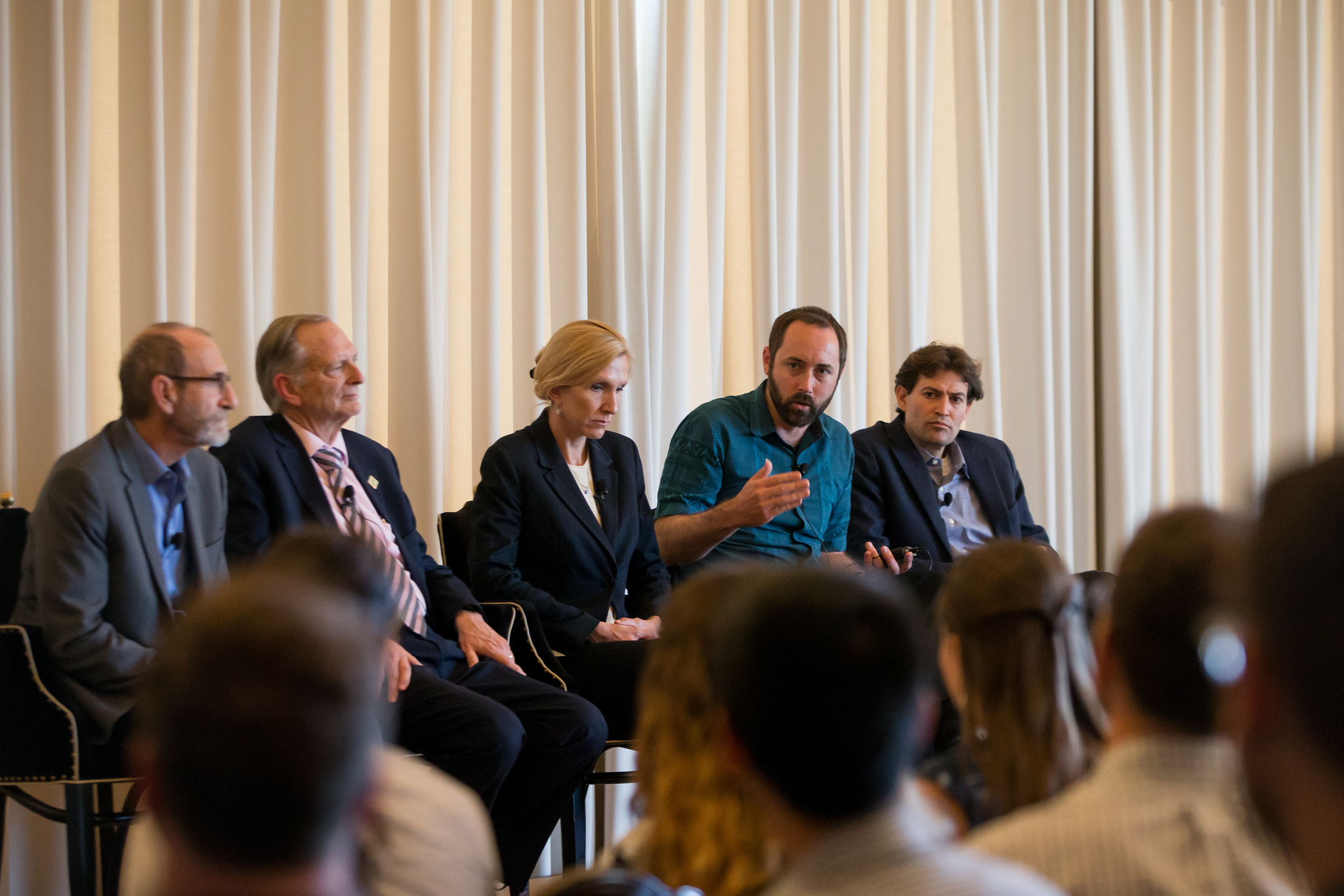May 22, 2018 | Woods Institute for the Environment | Insights
Stanford scholars met in Sacramento to discuss the growing threat of wildfires in California and what it means for managing the state's forests and public health.
The perennial threat of wildfire is a growing reality for many California communities. In 2017, almost 9,000 wildfires burned over one million acres of California’s forests and communities across the state, with major fires burning as late as December. Longer, more frequent droughts, higher temperatures, and unpredictable winds from climate change all factor in to the developing landscape of fire modeling and resiliency in California.
To tackle this issue, a group of Stanford scholars joined California State Assemblymember Dr. Bill Quirk in Sacramento, speaking at a briefing on “Fire and the Future of California Forests.” Over 120 people from government, non-profit, and business sectors gathered at the Citizen Hotel in downtown Sacramento, where the panelists focused on practical solutions to wildfires.
With a background in climate change science (he worked at NASA early in his career), Assemblymember Quirk is a rare scientist among his legislative peers. “We’re incredibly fortunate to have one of the pioneers in climate science in the California legislature,” said Chris Field, Perry L. McCarty Director of the Stanford Woods Institute for the Environment, when introducing Quirk. Assemblymember Quirk provided the keynote address, discussing the balancing act between fire recovery and resiliency planning, especially in the legislature. “How do you help people rebuild in a way that respects the environment they’re in?” he asked, emphasizing challenges that come with providing the resources needed to rebuild fire-torn communities while also continuing to deliver necessary services to those who weren't’t impacted. The assemblymember’s message was clear: these issues will not be solved in a vacuum. He emphasized the importance of collaborative planning and working closely with experts across disciplines to develop feasible, functional results.

Moderating the panel, Field also set the stage for an interdisciplinary approach when he underlined the many factors at play, “It’s about the forest, the economy, and the people,” he said, discussing the massive impacts of wildfire. The panelists, including Stanford professors Kari Nadeau and Noah Diffenbaugh, and Stanford Postdoctoral Scholar Benjamin Bryant, focused on the health of both humans and ecosystems in a changing climate.
Climate Change and the Co-Benefits of Restoration
“We now have clear evidence that humans are influencing extremes around the world,” said Diffenbaugh, who is also affiliated with Stanford’s Water in the West program. He went on to explain that “wildfires result from a confluence of events,” providing scientists with a complex, varying list of ingredients and extremes to sift through when studying wildfire.
With a focus on the co-benefits of forest restoration and conservation, Bryant (Natural Capital Project, Water in the West) explained that by aiming for a “win-win” between people and the natural world, we can boost the benefits to both. “Take, for example, California’s challenges with water: By removing match-like thin trees and built-up underbrush (“ladder fuels”) forest restoration also serves to increase the supply of water running into our reservoirs, and the lower intensity fires that result also reduce the potential for costly debris removal operations when we get heavy rain after a severe wildfire. This translates into direct benefits for water utilities generating power, and downstream farmers.” The Natural Capital Project works specifically in this space, using data-driven science to help quantify nature’s many benefits to people and providing decision-makers with tools to incorporate these benefits into planning. By showing how specific ecosystem services like forest restoration can mitigate wildfires and provide additional co-benefits, says Bryant, we can motivate more people to come to the table. Assemblymember Quirk agreed, “If we’re going to be able to do this, we have to show the benefits,” he said.
Health and Wildfires
Beyond environmental factors, health issues are among many people’s biggest concerns when exposed to fires. Many audience members wondered about the health impacts of the North Bay fires in neighboring places like Sacramento, where the smell of smoke lingered for days. “There is no safe distance away from a wildfire” said Nadeau, Director of the Sean N. Parker Center for Allergy and Asthma Research at Stanford. After the 2015 wildfires in Northern California, Nadeau says that there was a 45 percent increase in the risk of heart attacks for people over 65 years old in the burned areas, and that the rate of asthma increased by three times during those fires. “Smoke-derived particulates cause cancer, heart damage, immune problems and lung problems...you can smell and see some of the particulates, but not most” Nadeau warned.
Moving Forward
Issues around wildfire management and planning are complicated, requiring interdisciplinary discussion and debate. The pros and cons of controlled burns, for instance, sparked conversation between sectors at the panel. Controlled burning is a common tool among many traditional forest management professionals to renew forests safely, though those in the medical field point out the health impacts of any type of wildfire.
Conversations like this one can help California communities move forward in a changing climate, where wildfires are an everyday threat and our built world continues to expand. For more on the panel, see the full video and photos from the event.

![[Woods Logo]](/sites/default/files/logos/footer-logo-woods.png)
![[Bill Lane Center Logo]](/sites/default/files/logos/footer-logo-billlane.png)